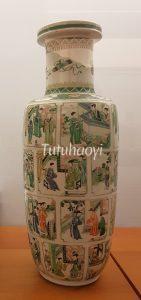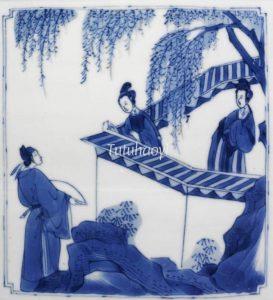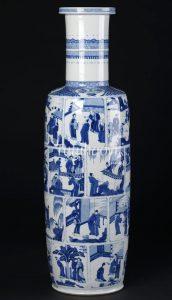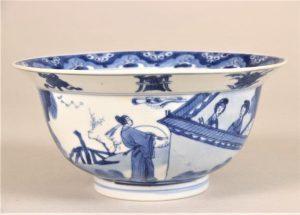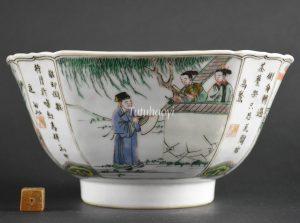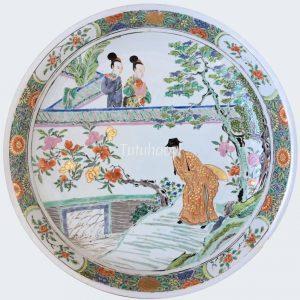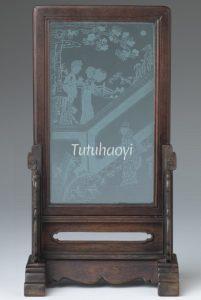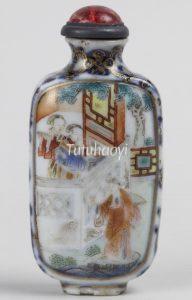Scholar Zhang and Cui Yingying exchanging verses in the garden
唱和东墙 (墙角联吟)
© Tutuhaoyi.com owns the copyright of the description content for the images attached. Quoting all or part of the description content on this page is permitted ONLY IF ‘Tutuhaoyi.com’ is clearly acknowledged anywhere your quote is produced unless stated otherwise. (本页描述内容版权归Tutuhaoyi.com所有,转发或引用需注明 “Tutuhaoyi.com”, 侵权必究, 已注开源信息的条目除外。)
This is from Scene Three of Act One of the Chinese classic popular drama Romance of the Western Chamber (西厢记 Xixiang Ji), written by the Yuan playwright Wang Shifu (1250–1336).
Zhang Junrui (张君瑞, also called Scholar Zhang 张生) was immediately struck by lovesickness after seeing Miss Cui Yingying at the first sight. He decided to rent a room at the Monastery of Universal Salvation 普救寺 in order to wait for an opportunity to get close to his goddess. Scholar Zhang inquired from a monk that Yingying would go to the garden to burn incense every night, so he hid behind the rockery in the garden and waited.
When Yingying came out of the corner door, Scholar Zhang saw that her fair face under the moon was even more beautiful than when he first saw her. He couldn’t help feeling love in his heart, so he composed a poem and read loudly:
The moonlight melts into the night,
Silent in the Spring, flowers in the shade.
Under the moon so bright,
Where is the beautiful maid?
(月色溶溶夜,花阴寂寂春;如何临皓魄,不见月中人。)
Yingying heard it and was touched by this refreshing poem. She composed another one to rhyme with his:
The orchid boudoir has been long lonely,
spending youth in vain.
I reckon that the poem chanter
should pity the sighing maid.
(兰闺久寂寞,无事度芳春;料得行吟者,应怜长叹人。)
Scholar Zhang and Yingying deepened their understanding through exchanging verses that night, and developed a sense of sympathy for each other, which laid their emotional foundation for having similar interests.
story scene description by Rachel Ma
Other episodes in the Romance of the Western Chamber:
Scholar Zhang embarking on his journey to sit for civil-service examinations 张生赶考
Scholar Zhang renting a room in the monastery 僧房假寓 (禅关假馆)
Repudiation of the Billet-Doux 张生跳墙 (乘夜踰垣)
Consummation of love from Western Chamber 月下佳期
Scholar Zhang getting drunk due to Madame Cui’s broken promise 张生醉酒 (崔母悔婚)
Fig 1: close-up, rouleau vase with overglaze enamelled decoration, Kangxi period (1662–1722), Qing dynasty, courtesy of The Guimet Museum, Paris, photograph by Mr JP Kim
Fig 2: rouleau vase with overglaze enamelled decoration, Kangxi period (1662–1722), Qing dynasty, courtesy of The Guimet Museum, Paris, photograph by Mr Riad Kneife
Fig 3-4: rouleau vase with underglaze blue decoration, Kangxi period (1662–1722), Qing dynasty, courtesy of the Victoria & Albert Museum, London
Fig 5: lidded porcelain jar with overglaze enamelled decoration, Kangxi period (1662–1722), Qing dynasty, courtesy of Palace Museum, Beijing
Fig 6: porcelain bowl with underglaze blue decoration, Kangxi period (1662–1722), Qing dynasty, courtesy of Seattle Art Museum
Fig 7: porcelain bowl with underglaze blue decoration, Kangxi period (1662–1722), Qing dynasty, courtesy of Princessehof Ceramics Museum, Leeuwarden, The Netherlands
Fig 8: porcelain famille verte bowl, Kangxi period (1662–1722), Qing dynasty, formerly in the Robert McPherson collection
Fig 9: porcelain famille verte dish, Kangxi period (1662–1722), Qing dynasty, courtesy of Christie’s Auction House, New York, 27 Jan 2014, Lot 344
Fig 10: porcelain famille rose dish, Yongzheng period (1723–35), Qing dynasty, courtesy of Galerie Nicolas Fournery, Paris
Fig 11: desk screen, Qianlong period (1736–95), Qing dynasty, courtesy of the National Gallery of Victoria, Melbourne. Photo: National Gallery of Victoria, Melbourne
Fig 12: porcelain snuff-bottle, Jiaqing period (1796–1820), Qing dynasty, courtesy of Princeton University Art Museum, object number y1936-991
Fig 13: copper lidded square tea tin with enamelled decoration, Qing dynasty (1644–1911), courtesy of Dongguan Museum, Guangdong Province, China

